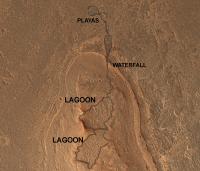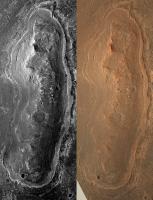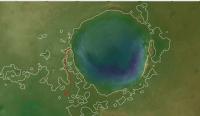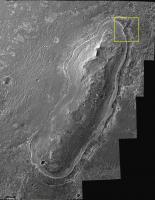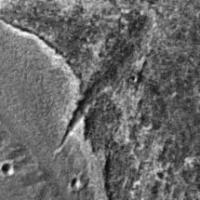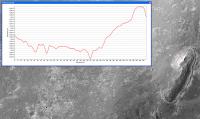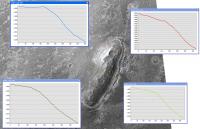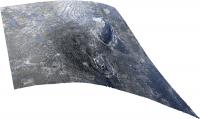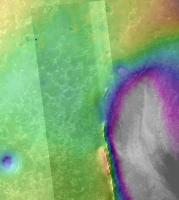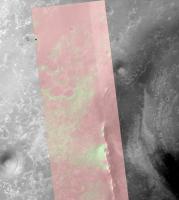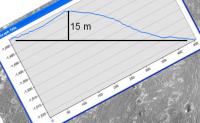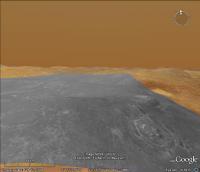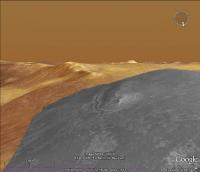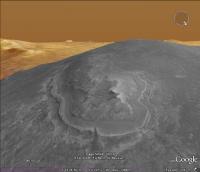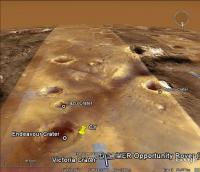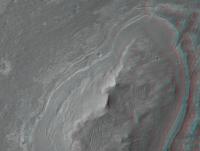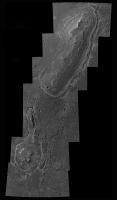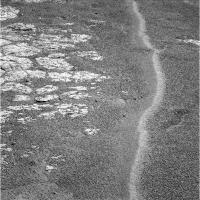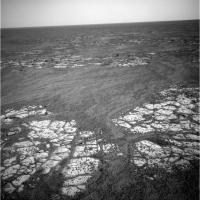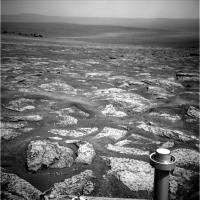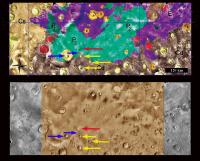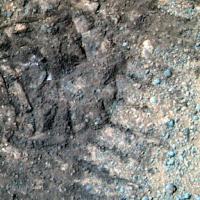Printable Version of Topic
Click here to view this topic in its original format
Unmanned Spaceflight.com _ Opportunity _ Geomorphology of Cape York and Solander Point
Posted by: Stu Jul 6 2010, 07:52 PM
Everyone, say hello to Cape York... in colour...
Larger version on my blog: http://roadtoendeavour.wordpress.com/2010/07/06/cape-york-in-colour
Posted by: ElkGroveDan Jul 6 2010, 10:26 PM
Thanks Stu. I've got my route and investigation sites all picked out. Only thing left now is getting my hands on the controls.
Posted by: algorimancer Jul 7 2010, 05:37 PM
...
This is a great picture, with fascinating geology going on.
For instance, being a crater rim, I would not expect neat layering; I find it difficult to explain the "ringing" about Cape York in a manner other than waterlines. I see at least 4 major levels. I'd love to see this in 3D.
At the upper end there is a steep wedge-shaped incision (see highlighted image below). Note that the wedge cuts through at least two of the "rings", and appears to project a fair distance to the north (?). I'm inclined interpret it as a landslide, but having difficulty with the mechanism; I suppose it could be an eroded fracture. In the highlighted image, the point of the wedge has its origin between the highlighted green and blue rings; this region is very smooth, such that I am tempted to interpret it as the remains of a beach. Sheer speculation, of course
Posted by: Phil Stooke Jul 7 2010, 06:18 PM
Those rings - don't think waterlines, the topography doesn't work - it's on a slope. Think instead: a very ancient crater rim that has had multiple layers of sediment (ejecta, windblown sand or dust, volcanic ash, etc.) deposited, cemented by fluctuating ground waters, and then differentially eroded. We see the end product of multiple depositional and erosional events.
Phil
Posted by: walfy Jul 7 2010, 06:28 PM
Eroded by wind only – is that right?
Posted by: algorimancer Jul 7 2010, 06:33 PM
This sounds sensible, with the caveat that slopes may be historically variable. You're almost certainly correct, though with the presence of groundwater presumed historically in the region where Oppy has heretofore traversed, and with (at least the interior of) Endeavour being dramatically lower, I would hesitate to definitively rule-out surface water until we get some on-the-ground verification. Aside from that, I'm still really intrigued by the Wedge.
Posted by: ElkGroveDan Jul 7 2010, 08:47 PM
With regard to the "wedge-shaped" cut...if you ask me I see a sinuous channel above the wedge and slightly east that you can follow up to the two depressions at the top of the formation. I've been staring at this for months and (call me crazy, go ahead) I can imagine the whole region covered in a slowly receding body of water.
The rim of Endeavour would at first have been something like a circular archipelago. As the water level receded you could see how two lagoons might have formed in those depressions. They might later have become lakes or ponds as the water receded almost to the base of Cape York. If something caused those those lagoons to drain suddenly to the north, you would get a meandering stream on the slope, but when it reached the steeper ledge of the apron it would have been a more energetic stream or even a waterfall that would have eroded backward creating the wedge.
You can also see how the channel becomes broader at the base of the cut where the slope becomes more gradual, creating something akin to an alluvial fan or a mini-delta. If you follow on past the wedge you can almost see a small round low lying basin next to a crater where the water might have collected before evaporating or settling into an underground water table.
Posted by: ngunn Jul 7 2010, 09:27 PM
Somewhere we have already had a nice stratigrapher's resume of these features but the interpretation there was that the 'waterfall stream' arrived at the wedge after flowing round the E flank of Cape York where there is indeed what looks like a narrow channel where the hill slope meets the 'beach' platform. Can I find the post? No. ![]()
![]()
Anyone remember it? We could use a link back to that, and the discussion it was part of.
EDIT: Gottit!
http://www.unmannedspaceflight.com/index.php?showtopic=6413&view=findpost&p=156342
Posted by: Bill Harris Jul 7 2010, 10:04 PM
+1 on Phil's observation: "Think instead: a very ancient crater rim that has had multiple layers of sediment ".
--Bill
Posted by: Stu Jul 7 2010, 10:50 PM
Some of you might find this useful... bit less blurry than the colour version...
http://twitpic.com/23b8o7
Posted by: serpens Jul 8 2010, 03:46 AM
The rim of Endeavour is really eroded and the meridiani hematite sedimentary beds fill much of the interior floor. Since the crater is lower than the playa region examined to date is it beyond the bounds of possibility that Endeavour region did in fact have a shallow lake?
Posted by: brellis Jul 8 2010, 07:23 AM
The pic from Stu's post 570 sure makes the Wedge look more like a fracture than a tributary or conduit for water.
Posted by: Bill Harris Jul 8 2010, 07:26 AM
Any possibilities are, well, possible. We'll need to see what the nature (stratigraphy, petrology and depositional environment) of the bedrock outcrops is as we travel downhill. Already we see subtle changes and the gross appearance from orbital imagery changes towards the East.
--Bill
Posted by: Drkskywxlt Jul 8 2010, 02:35 PM
What are the approximate dimensions of Cape York? Length, height, width... Thanks!
Posted by: Stu Jul 8 2010, 03:15 PM
VERY roughly, 660m long by 160m wide. Height? Image is too blurry on Google Earth to tell.
Posted by: algorimancer Jul 8 2010, 03:19 PM
A waterfall .... now, that's a neat idea. I'd envisioned a little rivulet gradually eroding the Wedge, but I rather like the waterfall idea.
A good stereo pair would be really helpful. That, or activate Oppy's heretofore unused (and undiscussed) JATO rockets to get there faster ![]()
Posted by: JohnVV Jul 8 2010, 03:28 PM
waterfall , i guess it is time to start to rethink my very old "blue mars" map so the next time some one wants to put it on a discovery chan show it will be " more" correct.
Posted by: algorimancer Jul 8 2010, 03:33 PM
Well, I said a "good" stereo pair would be helpful. Here's a cross-eyed pair, using the last couple of images posted. These may be from the same image, for all I know, but I'm pretty sure I'm getting a stereo effect, particularly around the Wedge. Overall quality is not great, but it's something different.
Posted by: Phil Stooke Jul 8 2010, 03:39 PM
I guess my reason for preferring a non-shoreline model is that I'm doubtful that an open body of water could have existed for long enough to create typical shoreline features like beaches, or that it would have been covered with ice, or that unconsolidated deposits like beaches could remain recognizable after all this time. Erosion might be slow on Mars but it can still have an effect on loose material. But I'll agree that other explanations than mine are possible, so let's see what we find. It might be interesting to consider what landforms or deposits you would expect the rover to see if this is a beach rather than superimposed layered sediment.
(PS this isn't distant vistas any more...)
Phil
Posted by: Bill Harris Jul 8 2010, 04:04 PM
Phil, my take on this is the deposition of and differential erosion of strata of differing resistances, deposited as essentially flat-lying beds over a pre-existing hill. Use known processes and KISS until you have proof otherwise.
--Bill
Posted by: Stu Jul 8 2010, 04:49 PM
Ask, and ye shall receive...
http://roadtoendeavour.files.wordpress.com/2010/07/cape-york-in-3d.jpg
Posted by: Stu Jul 8 2010, 04:51 PM
I think discussing Cape York here is valid, as we're all just waiting to see it appear on the horizon as part of the "distant vista", but if others agree with you then I'd be fine with someone starting a "Cape York" thread.
Posted by: ElkGroveDan Jul 8 2010, 05:02 PM
So let it be written, so let it be done.
Posted by: algorimancer Jul 8 2010, 05:26 PM
Great stereo, Stu (much better than the one I improvised). The more I look at this, the more I think "beach". Consider that, if Endeavour were flooded, with the water extending beyond the current rim (so that Cape York was an island), the big open deep water would be to the east of Cape York, and consequently the major wave action would be from that direction. All along the east side of Cape York is what appears to be a longshore bar, which might be expected from that wave action. This feature is largely lacking to the west. It makes sense that, as the water declined, water which accumulated behind the bar would channelize and flow through gaps. While the Wedge seems most prominent, I also see signs of channels to the south of it (immediately below the apparent small crater in the "bar", and a smaller channel at the northern "point" of Cape York. I see signs of channels feeding into these 3 outlets which are traceable southwards beyond half the length of the Cape.
Here's a portion Wikipedia's description of beach geology:
"There are several conspicuous parts to a beach, all of which relate to the processes that form and shape it. The part mostly above water (depending upon tide), and more or less actively influenced by the waves at some point in the tide, is termed the beach berm. The berm is the deposit of material comprising the active shoreline. The berm has a crest (top) and a face — the latter being the slope leading down towards the water from the crest. At the very bottom of the face, there may be a trough, and further seaward one or more longshore bars: slightly raised, underwater embankments formed where the waves first start to break.
The sand deposit may extend well inland from the berm crest, where there may be evidence of one or more older crests (the storm beach) resulting from very large storm waves and beyond the influence of the normal waves. At some point the influence of the waves (even storm waves) on the material comprising the beach stops, and if the particles are small enough (sand size or smaller) , winds shape the feature. Where wind is the force distributing the grains inland, the deposit behind the beach becomes a dune."
Posted by: Stu Jul 8 2010, 05:30 PM
Thanks, but can't take credit for that; I just used the IAS Viewer to view the already-existing anaglyph of the area, then stitched together four close crops of it. Thanks to the amazing HiRISE team for the stunning images!
Posted by: ngunn Jul 8 2010, 06:34 PM
Back to something I mentioned before but, since at last we have a special thread and more people contributing, here it is once more. It's about the beach/not-beach issue. One sure way to demolish the beach idea is to show that any hypothetical Endeavour lake would have had an outflow at a lower level than this terrace. If on the other hand the outflow point is found to be very close to the level of the terrace this could be seen as a 'fulfilled prediction' of the beach hypothesis. Lakes that drain can have levels that are stable for long periods, whereas lakes that don't tend to fluctuate or steadily decrease in level, militating against significant beach formation like Phil said.
I'm surprised that no-one here has seriously grappled with the relative elevations. I've made my own clumsy attempt and I think the elevations are fairly close - but that's really not good enough.
Posted by: algorimancer Jul 8 2010, 07:57 PM
It seems like Google Mars with the MOLA elevation database and overlaid high resolution imagery ought to get close to an answer. It's too bad it doesn't have the explicit capability of adding a water layer at a particular elevation, though this might be improvised (I'm afraid I just don't have the time lately, else I'd try it). One issue with applying this to ancient times may be that previously saturated subsurface/sediments may have subsequently lost water to sublimation and consequently altered the topography.
Posted by: Ant103 Jul 8 2010, 10:26 PM
Okay……
Posted by: djellison Jul 8 2010, 11:18 PM
I'm wondering if you could take word-pedantry to another website. Please, just don't have that discussion here, yet again.
Posted by: sariondil Jul 8 2010, 11:19 PM
Here is an attempt using a DTM from HRSC data (H3198_0001_DT4.IMG), blended with the nadir view (H3198_0001_ND4.IMG). The hypothetical shoreline in shown in white. It is more or less equivalent to the -1480 m contour (estimated from Google Mars because I introduced some sort of offset during file convertion). I can´t find a contour that completely surrounds the hill in question, but that may be because of the resolution of the DTM.
Still, this contour line implies a maximum depth of about 410 m for the lake, and some lagoons along the east rim (anyone want to look for shorelines?). Also, at this lake level the hypothetical lake would just begin to spill into a large basin to the southeast (along the red arrow; the contour lines begin to connect if the lake level is just a few meters higher). If the lake really spilled in that direction, I would expect to see some channels; but at a quick glance I don´t see any.
EDIT: Used the correct data set now and changed attachment accordingly.
Posted by: serpens Jul 9 2010, 02:24 AM
Trying to confirm a shoreline after a few billion years of erosion is a bit of an ask. What I do find interesting is that Cape York and immediate surrounds have phyllosilicates which would seem to indicate a long lasting, non acidic water influence. in the deeper areas around Cape York are the typical Meridiani sulphates indicating a second sedimentary deposition. In this scenario equating phyllosolicates to permanent surface standing water is really seductive.
Posted by: monty python Jul 9 2010, 06:03 AM
Just to toss in my 2 cents worth, when I look at cape york from above, I see the black hills of south dakota. They're a bit of old eroded mountain range complete with a "race track" of the spearfish formation forming a perifery around it. It's what a billion years of differential erosion will do. I know this is a crater rim but the same processes would apply. Any assymetries could be due to wind differences or the way the original crater rim was blasted out.
That cleft at the top is really interesting though!!
Posted by: ngunn Jul 9 2010, 08:45 AM
I was using the word 'beach' in a very lazy way as shorthand for 'shoreline feature'. I realise that in a geomorphology thread that's inappropriate and I apologise for the sloppiness. What we may call the Cape York terrace (though it can actually be traced around much of the Endeavour rim) has to be a hard formation to have resisted erosion in the way it apparently has. The result of some sort of concretion process happening at the lake margin maybe, rather than loose material emplaced by wave action. Another possibility is that it marks the stable stand of an old water table from a time when the whole of Endeavour was filled with porous sediments.
I also have been looking for signs of an outflow, but maybe in the wrong place. I thought the lowest gaps in the rim lay in the general direction of Iazu. There are some channel-like features there that appear to begin a short distance outside the crater and flow away from it.
Posted by: sariondil Jul 9 2010, 09:35 AM
Judging from the DTM I used in post #30, the lake would start to spill through Torres Strait if the lake level were only about 10 - 15 m higher. But the valley winding around Cape Tribulation appears to be lower.
Regarding the billions of years of erosion, I remember that the erosion rates for the last 2.5 billion years are thought to be extremely low (can´t find that paper right now).
Let me throw in two observations from my area: First, the South German Molasse Basin has a c. 15 million years old shoreline that is still, in places, a quite well-preserved terrace-like feature. And erosion rates are definitly higher than on Mars! I will look for numbers if you are interested.
Second, since this is a crater rim, I´m not convinced that the rocks of Cape York formed at its present place. The Ries crater in Bavaria (24 km) is known to have ejected relatively intact blocks up to 1.5 km in size. If Cape York were such a block, its rocks could have formed at a much deeper topographic level, and before the Endeavour cratering event. So, the phyllosilicates may have formed much earlier, and could be totally unrelated to the hypothetical younger shoreline.
Posted by: ngunn Jul 9 2010, 11:00 AM
Time for me to take another look at the Tribulation channel, viewing it as a possible exit. (In my mind's eye I had it flowing the other way.) Follow this link for Nirgal's 3D views of that location:
http://www.unmannedspaceflight.com/index.php?showtopic=6413&view=findpost&p=156417
Posted by: MarkG Jul 13 2010, 07:01 AM
I have my doubts about wave erosion and shores, at least of a free liquid water surface during the briny times Endeavour was formed. I think Mars was too cold by then, any body of water would be mostly ice-covered. I do think that an ice-layer (maybe thin) over brine is worth considering. There could be a situation with the Martian atmosphere below the water triple point, but wet brine would exist under ice bound to the soil. If the brine started to pool, it would then evaporate, but the soil would stay wet, but no (or few) actual liquid pools. This wetness could mobilize the overlying ice layer if on or near a slope, and a little erosion could occur (remember the ramps and headlands of Victoria?). The rim of Endeavour has a different composition and is above the local water table, so it would have a different history. And any soil water would not have the same brine content. It would erode/be-overlain differently.
Remember also that Meridiani is not like many other areas of Mars, no other area of extensive Hematite anywhere near its size exists on Mars (there are a smattering of smaller areas). So its history is not the same as the ancient northern ocean.
Posted by: vikingmars Feb 9 2011, 10:59 AM
Stu, your mosaic is great !
Thanks to it, I realized that one of the most interesting geological features to be seen on Cape York is "Dagger Valley" (outlined in yellow, a name I'm humbly suggesting) : a big incision with many layers surely to be sampled, like inside a small canyon. It exploration would complement our understanding of the history of past climate on Mars, as well as of Cape York itself... ![]()
Posted by: ngunn Feb 9 2011, 11:46 AM
Just a reminder - link back to Nirgal's 3D featuring Dagger Valley: http://www.thethirdplanet.de/mars_gallery/DEM_PSP_010341_1775/page-0004.htm
Posted by: centsworth_II Feb 9 2011, 01:16 PM
Then there's that "freshish" crater on the South end, with plenty of large ejecta blocks scattered about. Those are not likely to be blocks of the same Meridiani pavement that Opportunity has been traversing for years, but blocks of whatever yet unexamined material the ancient rim of Endeavour is made of. I'd like to see those up close!
What a conundrum! The two most interesting features of Cape York are on the two extreme ends. I wonder if in the final approach, Opportunity will be directed to either end of Cape York or if the "landing" will take place near the center as previously indicated.
Posted by: stevesliva Feb 9 2011, 04:08 PM
Caught my eye, too. If there's no accessible emplaced outcrop not buried in dust and rubble, that will be a likely place to look for some good rocks.
Posted by: MarkG Feb 9 2011, 04:56 PM
The "shore-like" features around Cape York are most likely the result of a combination of evaporite deposit-cementation and ice erosion. [IMHO].
It seems likely to me that any Martian body of water would be ice-covered nearly all the time, so any "shoreline" erosion features would be dominated by this layer of ice. Indeed, glacial patterns may dominate. Probably some sort of snow/brine freeze-thaw/dust cycle.
Terrestrial analogs?
Posted by: MoreInput Feb 9 2011, 09:08 PM
Just an intermediate hint (from Emily): There is a new paper, which covers all discoveries by Opportunity between sols 511 and 2300
http://www.agu.org/pubs/crossref/2011/2010JE003746.shtml
Abstract:
"Key new results include
(1) atmospheric argon measurements that demonstrate the importance of atmospheric transport to and from the winter carbon dioxide polar ice caps;
(2) observations showing that aeolian ripples covering the plains were generated by easterly winds during an epoch with enhanced Hadley cell circulation;
(3) the discovery and characterization of cobbles and boulders that include iron and stony-iron meteorites and Martian impact ejecta;
(4) measurements of wall rock strata within Erebus and Victoria craters that provide compelling evidence of formation by aeolian sand deposition, with local reworking within ephemeral lakes;
(5) determination that the stratigraphy exposed in the walls of Victoria and Endurance craters show an enrichment of chlorine and depletion of magnesium and sulfur with increasing depth. This result implies that regional-scale aqueous alteration took place before formation of these craters"
I am very interested in this paper, but it isn't public ![]()
Has somebody read it?
Posted by: serpens Feb 10 2011, 04:21 AM
Try this link
http://www.gps.caltech.edu/~grotz/Publications/Publications_files/2006_Squyres_Meridiani_Eagle_Purgatory.pdf
Edit: Sorry, wrong side of the ripple but may still be of interest.
Posted by: vikingmars Feb 10 2011, 09:50 AM
Totally agree ! If they choose the southern feature, it will be more easy then to rove south and explore the other capes...
So, with a geological point of view I would go north and explore Dagger Valley
With a Navigator's operational point of view, I would go south...
Posted by: pgrindrod Feb 10 2011, 04:31 PM
I've had a look at Cape York in my HiRISE DEM and I'm struggling to get much out of it topography-wise.
It looks like it's pretty low, ~6 m high (is that right?!), with something (albeit subtle) going on with those features around the edge. But to be honest, this area is really pushing the quality of my DEM: it's on a slope to the East, the MOLA shot points are scarce around here, and the surface texture is a bit dusty for pixel matching. So, combined with the vertical precision of my DEM being about 30 cm (I haven't checked), I'd only take this profile as a general guide.
But it's still fun nonetheless! 3D views (with same health-warning) to follow.
Pete
Posted by: fredk Feb 10 2011, 05:28 PM
This is great - thanks Pete. Have you tested your calculations on a known target, like Santa Maria or Victoria and gotten reasonable numbers?
How easy is it to do more profiles? Is it feasible to do several cutting right across Cape York so we can see if the results are consistent?
Anyway, such a short Cape York would certainly explain why we haven't spotted it yet.
Posted by: PDP8E Feb 10 2011, 06:18 PM
Pete., your Hirise DEM profile of Cape York is very snazzy! Thank you. I agree that the cape is kind of
short compared to what the overhead shot 'implies' (and the fact the we haven't seen it yet!)
Posted by: eoincampbell Feb 11 2011, 01:55 AM
So Cape York appears to be quite a bit inside Endeavor's "rim slope", I wonder when it will come into view, as sudden as Santa Maria ?...
Posted by: pgrindrod Feb 11 2011, 02:38 PM
Let's see if we can get anything else out of my DEM around Cape York.
I follow the standard USGS way of making these DEMs, so I'm happy with the method, it's just that the results can vary from place to place. I haven't made one around Victoria because, well, it had already been done, and Santa Maria was just off this stereo pair. But Doug and I had some success with a DEM of the pathfinder landing site (http://www.youtube.com/watch?v=uE_Ih0hgnlw), and I'm churning these out for my science at the moment and they match up well with MOLA, CTX, HRSC data. I guess Cape York is actually a nice test!
Profiles are no problem, but they're all pretty similar - the local slope into Endeavour just drowns most of the Cape York signal. That could be correct, or it could just be affecting the way that the DEM came out.
Here's a 3D perspective of Cape York, with a crazy x7 vertical exaggeration.
Looks pretty, but I wouldn't bet the house on it!
Pete
Posted by: pgrindrod Feb 11 2011, 02:47 PM
And while I'm filling up the place with images, I had a look at the visibility of Cape York from where Oppy might enter my DEM area.
First up a CTX base DEM with Oppy (green dot) just inside my HiRISE area. It shows up the relative depth of Endeavour compared to the really flat plains.
Then a visibility map (viewshed) of the raw unfiltered (hence noise) 1 m DEM from Oppy at the green dot. Cape York is not visibile as we'd expect.
I tried one the other way around, from the highest point at Cape York and basically you can only really see into the crater. So I guess if I'm right we won't see Cape York until we're right on it, but I'd be happy to be wrong.
Pete
Posted by: ElkGroveDan Feb 11 2011, 03:03 PM
I joked previously that maybe Cape York is nothing more than a stain on the ground. It looks like I wasn't far off.
Posted by: fredk Feb 11 2011, 03:23 PM
Thanks again, Pete. Those profiles certainly look consistent with each other. Subtracting off the overall slope, the tallest section (blue) gives around 15 metres height, which is starting to sound reasonable:
Posted by: vikingmars Feb 12 2011, 12:09 PM
... Meaning Cape York is well "climbable" by Oppy to get a better view (and to get a nice panorama) from its top : Endeavour's far rim and the other capes should give us a gorgeous view. Like many, I'm drooling over this upcoming view. Yum-Yum ! ... a "Yum-Yum" Pan. Bon Appetit ! (besides, it's lunch time right now in France)
Posted by: BrianL Feb 12 2011, 03:53 PM
Looking at that 3D view, Cape York seems less like a hill to climb, and more like a ledge to drive out onto. I am so looking forward to arrival day. I almost wish I could fast forward to that event. Except that would probably mean winter is just starting again, and I am really, really tired of winter right now. ![]()
Posted by: climber Feb 12 2011, 08:43 PM
What are you talking about? Arrival time will be by Easter
Posted by: serpens Feb 12 2011, 11:05 PM
Fred, I'm not sure I follow your logic here. Wouldn't a line of best fit along the plains approach section of the plot give the baseline to estimate the height of Cape York above the plain? I make the maximum height of the blue plot to be around three to four metres?
Posted by: fredk Feb 13 2011, 03:38 AM
You might be right about that, but I think we'd need to see how the profiles look farther out to know for sure where the plains "start". And as others have said, if that overall slope is right, this isn't a hill, it's more like a ledge to drive out on.
Posted by: Stu Feb 13 2011, 07:31 AM
Ok... trying to get my head around this... We're now thinking that Cape York isn't so much a "hill" as a kind of a "ledge" or platform sticking out from the inner slope of Endeavour...? Does that mean the hills that curve around the southern edge of the crater are the same? This is fascinating...
On another note, it was pleasing to find a LOT of interest in the MER mission last night when I gave an Outreach talk out at a little village just outside Kendal. "Mature" crowd, shall we say, general level of interest in science, but still, the ones who were aware that there are rovers on Mars were fascinated by them, and very impressed by what they've achieved.
So say we all.
Posted by: serpens Feb 13 2011, 08:15 AM
The perennial problem with visual representations using axis with the same metric but different scales is the gut reaction 'gee that's steep'. It isn't a particularly steep gradient and rather than a ledge overlooking a chasm it is more of a low ridge with a (roughly) ten degree slope into the crater.
Posted by: Stu Feb 13 2011, 08:18 AM
Gotcha, thanks.
Still... hill... ledge... island... ledge...
I need more tea.
Posted by: CosmicRocker Feb 13 2011, 08:37 AM
That's right, Stu. The profiles in pgridrods's first image in http://www.unmannedspaceflight.com/index.php?s=&showtopic=6667&view=findpost&p=170502 show it very nicely, even if the vertical and horizontal scales are not identical. Those profiles are essentially showing that Opportunity will not really need to climb up to get on top of Cape York. The idea to take away from this whole discussion is that Opportunity should be able to drive right over the top of Cape York with little trouble, unless boulders or loose sand block the way. The steepest slopes are on the back side of the Cape, and those apparently average 7-9 degrees.
Regarding the hills to the south, his topo maps posted above and http://www.unmannedspaceflight.com/index.php?s=&showtopic=6438&view=findpost&p=170023 show them to have much more significant topography.
Posted by: Stu Feb 13 2011, 08:43 AM
Thanks cosmic; I had read those posts... I was just recapping whilst virtually banging my head against my computer screen! ![]()
I've just been messing about on using Google Mars with the latest .kml file, and if you stretch the vertical exaggeration to 3 the true nature of Cape York becomes clearer...
When you look at it more closely it looks like material flowed and rolled over Cape York from the west, doesn't it..?
Posted by: serpens Feb 13 2011, 09:55 AM
Stu. I see what you mean. The NW rim has been eroded flat and the Meridiani sulphate sediments have flowed into the crater. Flowed tends to imply fluvial action but that terrace around Cape York does remind me of a shallow shoreline, sandbar – rip channel system. Vikingmars’ "Dagger Valley" at the North end fits that scenario as a rip outflow channel. Cape York may be topography challenged but it is a fascinating destination.
Posted by: ngunn Feb 13 2011, 12:46 PM
Stu - or anyone handy with Google Mars - can you identify the hills on the horizon behind Cape York in your two lower views?
Posted by: Stu Feb 13 2011, 01:40 PM
Wider angle view...
Remember, tho, that everything is vertically stretched x3
Posted by: CosmicRocker Feb 13 2011, 05:20 PM
You have to be very careful when looking at elevations using Google Mars. As I and others have pointed out, most of the topographic information used in Google mars is based on the MOLA coverage, which is not uniform, and typically not very closely spaced. Large stretches of Endeavor's rim were not sampled at all by MOLA shot points, so elevation maps derived from them do not display accurate elevations where topography is changing rapidly between MOLA lines and sample points. Emily posted a very nice kml file that will display those shot points in Google Mars. I think it was in the Distant Vistas thread.
One area of Mars that has higher frequency elevation coverage in Google Mars is Victoria Crater. That area has been populated with a digital elevation model based on more closely sampled points, probably based on a HiRise stereo pair. If you look at Victoria Crater in Google Mars you will see much more topographic detail than most anywhere else.
Posted by: Stu Feb 13 2011, 05:24 PM
Oh I agree, absolutely. I don't rely on GM, good as it is, for anything. But it is useful for giving a 'general impression' I'm sure you'll agree.
Posted by: ngunn Feb 13 2011, 06:09 PM
Thanks. So, am I right in thinking that's part of the Miyamoto rim in the background? (Sorry, OT I know.)
Posted by: elakdawalla Feb 14 2011, 03:28 AM
I'd like to remind those of you engaging in this discussion of http://www.planetary.org/blog/article/00002638/ in which I brought all of the available MOLA ground tracks into Google Mars. You can see that all the ground tracks completely miss the entire western rim of Endeavour, so the MOLA data simply doesn't record the elevation of the rim. It's not in the data at all. It would be a much more productive exercise to do photoclinometry or develop a DEM from stereo imaging, as pgrindrod is trying to do...
Posted by: Stu Feb 14 2011, 06:40 AM
Oh, heck, we were just having a bit of fun speculating.
But ok, I'll go tidy my room... ![]()
Posted by: ElkGroveDan Feb 14 2011, 06:49 AM
... and while you are up there write out 100 times THERE IS NO MOLA DATA FOR THE RIM OF ENDEAVOR CRATER or there'll be no wandering around that castle of yours in the dark this evening, young man.
Posted by: pgrindrod Feb 15 2011, 05:30 PM
Just to add to the ways of getting across the geomorphology of Cape York, here's a red-blue analglyph of my Cape York DEM (plus contours).
And just in case that isn't overkill, here's a movie of the same area.
http://www.youtube.com/watch?v=UZhmePA5r24
As you can tell, the resolution is turned way down in that movie (still managed to crash my computer several times!), and I don't yet have my pilot's licence. If my computer doesn't melt, expect a flurry of these things.
Pete
Posted by: CosmicRocker Feb 16 2011, 08:00 AM
Nice, Pete; but I think you got the red and cyan layers reversed. We can put our glasses on backwards to make it work, but if you are going to crank out a flurry of these things it might be best to reverse the colors. ![]() Thanks for all the good work, by the way.
Thanks for all the good work, by the way.
The animation was very effective. ![]()
Posted by: mhoward Feb 16 2011, 05:30 PM
Excellent movie and anaglyph. But yes, the red and cyan layers need to be reversed, or we need to wear our glasses upside-down.
Posted by: marswiggle Feb 16 2011, 07:59 PM
While we have seen very nice DEMs and a couple of lower-res anaglyphs of Cape York, I just thought an anaglyph in original size would be interesting for comparison. Only the north part was able to be included here within the maximum upload size, however I hope it's worth it.
Posted by: Stu Mar 31 2011, 03:48 PM
Now that we're officially "on our way", I thought it might be useful to compare the size of some of the major features and landmarks on Cape York with Oppy, so here you go... You'll see some orange "spots" on the landscape when you zoom in on it. The dark pixels in the centre of the dot shows the size of Oppy. Not easy to see, I know, so I'll post a higher resolution version on my blog later...
As usual, this is intended to be a rough guide, not a definitive one.
Update: large version posted to my Twitpic account: http://twitpic.com/4fckki/full
Posted by: bgarlick Jul 19 2011, 06:19 PM
While we are waiting to see Cape York, some Geology questions...
Cape York is lower than our present position (if it wasn't we would already see the peaks of Cape York above the horizon).
So... Will Cape York be covered in sulfate deposits and blueberries?
If 'Yes', then how come Cape York looks so distinctive from orbit with clear boundaries to the plains of Meridiani? If it was covered in sulfates and berries like everywhere else CY should appear as just a nondescript smooth bump.
if 'No', then how can you have Cape York be free of sulfates and berries if it is lower elevation than our current location? If Meridiani was created by a pool of evaporating water, then CY should have even more deposits on it than we see where we are now since it is at a lower elevation. Basically, how can you have an 'island' that is below the sea bed!? Presumably CY has not subsided... Note that from space CY shows different materials (such as clays) which implies that it may not be covered with sulfates and blueberries.
I am not sure what the answer is to this dilema. Does anyone have an explanation? One thought I had off the top of my head was that the sulfate deposits are from groundwater seepage (as has been proposed) with a geology sequence something like..
1) Endevour impact
2) vast deposits of basaltic sands introduced (which we see are underneath the thin sulfate deposits here)
3) sand gets blown around and out of Endevour crater so that around the rim there are sand deposts that are higher than the actual Endevour impact crater rim (ie higher than CY)
4) sand is also blown off CY or never even accumulated on it
5) water seepage comes to the surface, depositing sulfates, but water does not seep 'up' CY because it is too far for water to seep upwards and/or because it is made of impermiable rock instead of basaltic sands
6) water seep stops, sulfates erode leaving blueberry lag depost (except on CY )
So, I think it will be very interesting to see if CY has blueberries/sulfates on it or not....
Thoughts? ![]()
-Ben-
Posted by: Julius Jul 19 2011, 06:32 PM
I am no planetary geologist and therfore may not be knowledgable to answer such queries but I think that CY forms part of endeavour crater rim and thus represents material excavated from deeper layers on Mars which presumably contain the clays which predate the sulphates!
Posted by: centsworth_II Jul 19 2011, 06:56 PM
Posted by: bgarlick Jul 19 2011, 07:14 PM
This is quite plausable. In this case we should see a blueberry lag deposit directly on the clays (ie the sulfates are all gone in places). Blueberries over clays (and other CY rim materials) would look different than blueberries over sulfates & sands (which we are driving on) and would explain why CY is destinctive looking even though it is lower than the plains.
Posted by: marsophile Jul 19 2011, 08:22 PM
There has been no mention of a hematite signature from Cape York. Wouldn't a blueberry lag deposit produce such a signature?
Posted by: Phil Stooke Jul 19 2011, 09:15 PM
The CRISM composition data certainly don't seem to point to a blueberry layer on Cape York... but it's certainly legitimate to ask why not, if the whole area was covered with the plains material and it has eroded away. One possible explanation - blueberries were more common in some areas than in others, and this may be an area where they were not found to begin with. Test - look for blueberries in the plains immediately adjacent to the Cape.
Phil
Posted by: bgarlick Jul 19 2011, 11:00 PM
If that is indeed the case, ie no berries/sulfates on CY while berries are [presumably] on the plains right around CY, then we have a head scratcher here and this might point more towards a groundwater source of the sulfate/hematite instead of an evaporated body of water (which would have had to have covered CY since CY is lower than the surrounding plains) as I proposed in my original post.
Note: I am not a Geologist, but my dad is... :-)
-Ben-
Posted by: marsophile Jul 19 2011, 11:20 PM
That might not follow. Flood waters pouring over a cliff will take the path of least resistance, and will avoid locally higher obstacles. It is only if the entire area was submerged that CY would necessarily have been covered.
Posted by: fredk Jul 19 2011, 11:58 PM
Moderators: perhaps this discussion should be moved to the "Geomorphology of Cape York" thread?
Posted by: serpens Jul 20 2011, 12:34 AM
The topography inside Endeavour would seem to indicate that the sediments flowed into the crater from the NW. The contours also seem to indicate a slightly steeper channel just to the south of CY. It is pretty clear that the blueberries formed within the sediments and whether there was just groundwater or whether there was a surface water overlay would seem immaterial. Low profile notwithstanding the feature is fascinating, but concentrating on the geomorphology of Cape York in isolation rather than standing back and considering it in the context of Endeavour Crater as a whole could be a bit limiting.
Posted by: Gladstoner Jul 20 2011, 01:23 AM
.
Posted by: centsworth_II Jul 20 2011, 03:32 PM
Does CRISM really show no hematite signal from Cape York, or is it just that that is not where the focus of attention is at? Phyllosilicate and hydrated sulphates are the focus, but does that mean the hematite is not there or just not being talked about?
I think I will be more surprised to see few berries on Cape York than many. Just because I think The Cape was covered by the same berry containing layers that eroded away and left berries over the rest of Oppy's route. But maybe berry forming layers never did extend over Cape York. It will be interesting to see.
Posted by: centsworth_II Jul 20 2011, 03:59 PM
Posted by: Gladstoner Jul 20 2011, 06:44 PM
.
Posted by: Gladstoner Jul 21 2011, 12:12 AM
.
Posted by: Juramike Jul 21 2011, 01:05 AM
I think I like your very first diagram the best (post 87 http://www.unmannedspaceflight.com/index.php?s=&showtopic=6667&view=findpost&p=175794). It explains the similar unit at the margin surrounding the central material of the ancient rim.
I'm not sure how I see that the interior layers could get bent to follow the crater interior. The initial whack should've gouged a big hole, and any layers that formed afterwards should have been dropped in parallel and flat. Any tilting after that would be uniform across the region...and you should see that as a difference in remnant rim heights.
Posted by: Gladstoner Jul 21 2011, 01:37 AM
.
Posted by: Gladstoner Aug 9 2011, 12:48 AM
.
Posted by: Juramike Aug 9 2011, 01:05 AM
I'm not sure, but I think the uplifted rims of Endeavour were subjected to erosion and probably made a local mantling deposit at the base of the rim crests. Then additional materials were laid on top of that too. Then it was exhumed as you've described in your drawing.
(So take the drawing you did on June 18, then add a layer on top that then gets exhumed.)
Posted by: Gladstoner Aug 9 2011, 01:16 AM
.
Posted by: centsworth_II Aug 9 2011, 01:16 AM
Posted by: CosmicRocker Aug 9 2011, 04:35 AM
centsworth_II: There was an ejecta layer at Victoria. There's not a continuous deposit across Meridiani as the drawing suggests, but at Victoria we drove over the planed surface of the ejecta blanket and also saw it in cross section on the capes. It should be drawn as a discontinuous layer. I agree that on many of the ancient craters the ejecta has been removed (Erebus, for example), but I think it is ok to show it schematically.
Posted by: centsworth_II Aug 9 2011, 06:33 AM
Ninety percent of the Meridiani that Opportunity has shown us is characterized by a fractured sulphate pavement covered by a thin ripple layer of sand. I think this sulphate pavement is unmoved since it was formed from wind deposited sediment layers, subsequently acted on by water. I don't think it is a bed of ejecta.
Just adjacent to Cape York, this sulphate pavement seems to be a little jumbled. But I still think it is essentially the original wind placed Meridiani layers, not redistributed ejecta. Of course, I could be wrong.
Posted by: Juramike Aug 9 2011, 10:33 AM
So you are thinking that the Endeavour ejecta is buried deep below the "Meridiani wind deposited then aqueous-altered" layers and probably not well exposed?
Below the yellow and brown layers in Gladstoner's graphic (which I really like, BTW).
(...Makes sense to me.)
Posted by: centsworth_II Aug 9 2011, 02:26 PM
From these images -- and many other papers on Meridiani -- it is clear that Endeavor and its ejecta is buried in up to hundreds of meters of Meridiani deposits. The only visible part of the original crater are the rim peaks (including Cape York!).
Some quotes from the paper:
"We have completed a regional analysis of the hematite deposit in Terra Meridiani and
conclude that the unit is in the midst of a 600-m-thick stack of friable layered materials
superposed on Middle and Late Noachian cratered terrain."
"The hematite (P2) is in the midst of a complex stratigraphic sequence of layered materials. These younger
layered deposits (P1, P2, P3, E, I) are superposed on ancient cratered terrain..."
"The layered deposits clearly bury the underlying cratered terrain..."
Posted by: Julius Aug 9 2011, 03:00 PM
Cant recall where but i had read that there was a possibility that the water activity in meridiani could be related to lava coming into contact with ice underground when the tharsis bulge was forming... meridiani lies on a slope from the tharsis bulge and mariner valley is close by!
Posted by: Gladstoner Aug 9 2011, 07:31 PM
.
Posted by: john_s Aug 9 2011, 09:42 PM
I don't see any reason to invoke a significant ejecta layer on top of the Meridiani sulfates near Cape York. The only places we've seen significant ejecta have been very close to the individual craters that created the ejecta, and there are no large craters near Cape York that post-date the Meridiani sediments. The surface bedrock here does look kinda broken up, but that could be due to the ubiquitous shrinkage fracturing that we've always seen, coupled with downslope movement and settling stresses associated with being draped over the Endeavour rim.
John
Posted by: Gladstoner Aug 9 2011, 10:23 PM
.
Posted by: john_s Aug 9 2011, 10:43 PM
The ejecta from that crater would be *under* the Meridiani sediments, as it pre-dates them. We might see some sign of it on Cape York, though...
John
Posted by: Gladstoner Aug 9 2011, 10:54 PM
.
Posted by: MarkG Aug 10 2011, 02:02 AM
It seems that Endeavor was created before most (if not all) of the Meridiani sediments were emplaced. The sections of exposed rim of Endeavor are essentially ejecta from the Endeavor impact. After that impact, the Meridiani sediments were laid down, perhaps with rounds of erosion in between. Did the raised rim sections get buried/eroded? Cape York sure looks like a piece of the rim that was long ago buried, and now is being exhumed. Other higher parts of the rim may or may not have been buried. Were these "islands" eroded by wind? water? ice? brine slime?
Note the Endeavor central plateau, with hundreds of meters of sediment, worn away most just inside the rim. It is amazing what can happen slowly if you've got a couple billion years...
I've noticed that the sediment layering partially follows the slope -- not sure without better analysis. It is possible that the circumferential "zones" around Cape York may be more chemical in nature than structural. I.e, just different strength and chemistry of the matrix just due to original ionic groundwater diffusion from the older rim ejecta. We will soon see.
I'm having great fun thinking about it all.
Posted by: Gladstoner Aug 10 2011, 02:10 AM
.
Posted by: serpens Aug 10 2011, 02:54 AM
Unfortunately almost all analysis published is concentrated on a small section of the western rim and the big picture of Endeavour and surrounds seems to receive little attention - or I may have missed the published data? With the exception of a couple of meteorites designated as having a Martian origin the ejecta we have passed has been displaced Meridiani sediment and the blocky ejecta just ahead will hopefully be our first opportunity to sample the ancient bedrock. The sediments have over-run the NW crater rim and part filled the crater so the original surface and overlaying Endeavour ejecta should be well buried, as John pointed out. The hematite response mapping indicates a high concentration inside the crater which would indicate that the mound is the ubiquitous cemented sulphates and that the crater has had significant water influence. But the mapping scale doesn't provide much discrimination.
Now that we can get a good look at the rim it seems well eroded. Is it ejecta or uplifted / overturned bedrock? The sediments seem to onlap the westerly side of the rim rather than being covered by material eroding from the rim and it would appear that there has been little erosion of the rim material since the sediments were laid down. So I tend to think that Mark's chemical alteration hypothesis for the terraces looks pretty good. We'll soon find out as Opportunity can now get back to being a geologist rather than a tourist.
Posted by: Bill Harris Aug 10 2011, 03:37 AM
Agreed, Serpens.
At this point we can see as much sitting a few meters from the contact as we have seen a few kilometers above the site. We'll know more next week when we do get to the contact, but for the time being, closely evaluating this transition zone is important. We'll know more when we know it.
I think the basic scenario here is simple. Endeavour crater was created on the basaltic basement and is unconformably overlain by the later aeolian/lacustrine (or, more properly, "playan") sediments of the Burns Fm. At this time, we don't know what the paleo-surface of the was like, nor what the many depositional or erosional environments that occurred over the billions of years between the "Endeavour Age" and the "Burns Age" are like. I feel certain that the CRISM phyllosilicate signature(s) are from an old weathering surface on the upturned basalt of the Endeavour rim, and more specifically, the nearby phyllo-signature is from weathered and covered ejecta from a crater in this weathering surface on the Cape York crest.
Who knows, it may even be the "Betty Bluep" rocks we saw at Sata Maria or the elusive "5YR 4/3 outcrop" brown argillageous-looking outcrop we've seen along the way.
These are interesting times...
--Bill
Posted by: tim53 Aug 12 2011, 09:25 PM
While it is generally accepted that vast amounts of erosion of sediments over broad areas of the highlands has produced crater "mound" remnants like those in Endeavour, it isn't really true that sedimentary deposits are always deposited horizontally and continuously to their maximum elevation over a region.
The martian polar layered deposits are a good, familiar example of a subaerial deposit that is thick but never (likely) extended across the northern plains to the elevation of their summit. The layers are also not horizontal.
The Bahamas are an excellent, familiar example of a subaqueous deposit that is kilometers thick but never extended across the Atlantic Ocean basin.
Once again, however, many on the MER project accept the model of extensive erosion of the Meridiani Planum sulfates.
It will be interesting to see if there are blueberries on Cape York, indeed. If there aren't, it might suggest that Cape York was never buried by sulfates. But it also might be possible that the geochemistry of the groundwater within the rim rocks wasn't conducive to hematite concretion formation.
It's a hypothesis!
-Tim.
Posted by: MarkG Aug 13 2011, 03:37 PM
One thing evident from the pictures of Cape York is a zone of "reduced topography" inside of, but concentric to, its boundary. One can speculate that this represents a "zone of alteration" of the original rim deposits after burial by the sulfate sediments.
The Odyssey crater is centered on the inner boundary of this zone, and indeed the northeast half of the rim debris is made up of larger (stronger) rocks, while the southeast half has almost no large rocks, presumably because the zone-of-alteration made debris from that side more friable.
It is also possible that this zone represents an ancient soil layer in the rim deposits, and that role, rather than alteration by the subsequent Meridiani sulfates, made them more friable.
The presence of obvious intrusive veins in the rocks currently under Oppy is another constraint on understanding things. Do the big rocks on the other side of Odyssey contain such veins?
The remainder of Oppy's scientific functionality will be well-challenged to answer these questions. But we are indeed positioned to ask them.
Posted by: brellis Aug 13 2011, 06:26 PM
(edit: thinking ahead) Perhaps a spot can be found to park Oppy for the winter and point mini-TES at something interesting for a long time?
Posted by: djellison Aug 13 2011, 06:31 PM
It's not integration time that's the problem. It's just contamination. It can't see out. It's filthy.
Mossbauer, on the other hand - that's just an integration time problem....so many weeks might be necessary.
Posted by: Eutectic Aug 19 2011, 10:58 PM
As kenny noted on August 14 in the Cape York thread, some of the large boulders may have split along veins. We now see Tisdale and at least one boulder east of it with a surface that may be what's left of veins they split along. So, pending confirmation that the light boulder surfaces are in fact equivalent to the veins in the ground, observations east of Odyssey to date are consistent with an answer of "yes".
Posted by: CosmicRocker Oct 18 2011, 05:35 AM
On sol 2748 a series of subframe images described as pancam_foreground were taken. Attached is an L456 false color composite from that series. I don't think we can say we see blueberries with certainty from this single image, but several of the pebbles in this image appear to be quite spherical and have approximately the right color to be the concretions.
Unfortunately, the R5 image has a large data dropout in the critical area, otherwise I could make a right filter, false color composite that could unambiguously identify hematite. I'll watch for the full R5 image to come down and will post the right filter composite when it does.
Posted by: Bill Harris Oct 18 2011, 06:15 AM
Try L257 and R721 images for this.
In this image set I've seen several nice rounded pebbles, but none that seemed unambigiously Blueberry-ish.
We'll keep looking.
--Bill
PS-- I was going to put these on the Photobucket site tomorrow AM, but I decided to do 'em tonight.
http://i142.photobucket.com/albums/r91/wilga_photo/Oppy/L257-1P372134180ESFBP00P2559L2M1.jpg
http://i142.photobucket.com/albums/r91/wilga_photo/Oppy/R721-1P372134562ESFBP00P2559R7M1.jpg
--b
Posted by: Bill Harris Oct 19 2011, 02:07 PM
--Bill
Topic split as requested - http://www.unmannedspaceflight.com/index.php?showtopic=7090 - Moderator
Posted by: CosmicRocker Oct 19 2011, 03:23 PM
I think you split the posts at the wrong place. My original observation that blueberries may have been observed in the sol 2748 pancam_foreground images is highly relevant to the discussion of Cape York's geomorphology. ![]()
A couple of posts moved back - Mod
Posted by: CosmicRocker Oct 23 2011, 02:51 AM
![]() Many thanks, anonymous Mod.
Many thanks, anonymous Mod. ![]()
Posted by: CosmicRocker Oct 25 2011, 03:15 AM
I'd like to follow up on my http://www.unmannedspaceflight.com/index.php?s=&showtopic=6667&view=findpost&p=179322 about possible blueberries (hematite concretions) in pancam images from sol 2748 on Cape York. It had been suggested that if a residuum of such concretions would be found on top of the very different geologic bedrock of Cape York, it might mean that the cape had previously been buried by the blueberry containing sulfate sandstone that covers Meridiani Planum.
Since the target was imaged with a full set of infrared filters, we can make a false color image based on pancam right filter ratios that has successfully identified hematite in the past. In such false color images hematite typically appears in shades of yellow or orange. Some of us http://www.unmannedspaceflight.com/index.php?s=&showtopic=7090&view=findpost&p=179325 this image processing in another part of the forum.
Getting to the bottom line, http://www.unmannedspaceflight.com/index.php?act=attach&type=post&id=25783showed plenty of hematite in the ground Opportunity is driving over. There were numerous spherical hematite concretions as well as angular fragments of hematite visible in the image. The question now becomes, How did this hematite arrive on top of Cape York? It seems to me that there are three alternatives:
1: It dropped down onto the basement rocks as a lag deposit as overlying sulfate sands were eroded away.
2: The concretions and fragments were transported to their current location by wind or water currents from the surrounding plains.
3: They were thrown onto the cape by meteorite impacts on the plains.
I think it may be difficult to distinguish among the alternatives. Are there other alternatives that I missed? I would have liked to provide a thumbnail link to the above image, but I still have not figured out how to do that without uploading the whole file again.
Posted by: ngunn Oct 25 2011, 09:29 AM
4: Condensation lapilli (distinct from your no. 3, I think)
Disclaimer: doesn't mean I believe this, just that if we're brainstorming upon finding the things in an unepected location nothing should be dismissed.
Posted by: Bill Harris Oct 25 2011, 06:00 PM
I see angular and rounded pebbles with a "hematite signature" but not to the extent that I can call them "blueberries". We've not seen these rounded pebbles in-situ, nor broken in x-section, so I can say that they are blue, but can't say berries.
And, as Nigel suggests, they may be lapilli. One characteristic of this region of Mars is the abundance of various Iron (III) oxides and hydroxides. And we don't have much experieces locally with hematites as impact melts.
The western slope of CY is so shallow that some "onlap encroachment" is indeed possible, especially at this highly-eroded point on the Endeavour rim. So a blueberry or two wouldn't be earthshaking. Those clasts do simply _look_ rounded, and not necessarily blueberrish. So the jury will be out til we get more mineralogical data.
--Bill
Posted by: CosmicRocker Oct 26 2011, 04:35 AM
I understand what you are saying, Bill. It would be nice to see these pebbles on the surface rather than embedded in the soil, and a x-section would be the icing on the cake. A wheel scuff to dig a few of them up would help a lot. However, I don't think it is such a stretch to imagine that the most obviously round ones are truly spherical and not simply pebbles rounded by erosion. If you can imagine that, and accept the evidence that these things are indeed hematite, it is simpler to assume the spherical pieces of hematite are the same ones we've been seeing all these many years through Opportunity's eyes, rather than assuming some other origin for them.
This is really an interesting soil image. The abundant, angular pieces of hematite are very curious. We have rarely seen gravel composed mostly of hematite and with a large population of angular fragments. It looks like a bimodally sorted size distribution and perhaps a bimodal shape distribution as well. I'm not sure what that means, but it could possibly be evidence of a very different transportation mechanism than we have normally observed for the hematite fragments. If I had to guess, I'd suspect a higher energy environment.
Posted by: brellis Oct 26 2011, 07:16 AM
Over the years, there have been many discussions of "shorelines" as theoretical possibilities or dry analogs.
Could we be for the first time approaching an actual ancient shoreline? How would that confirmation happen?
Powered by Invision Power Board (http://www.invisionboard.com)
© Invision Power Services (http://www.invisionpower.com)



